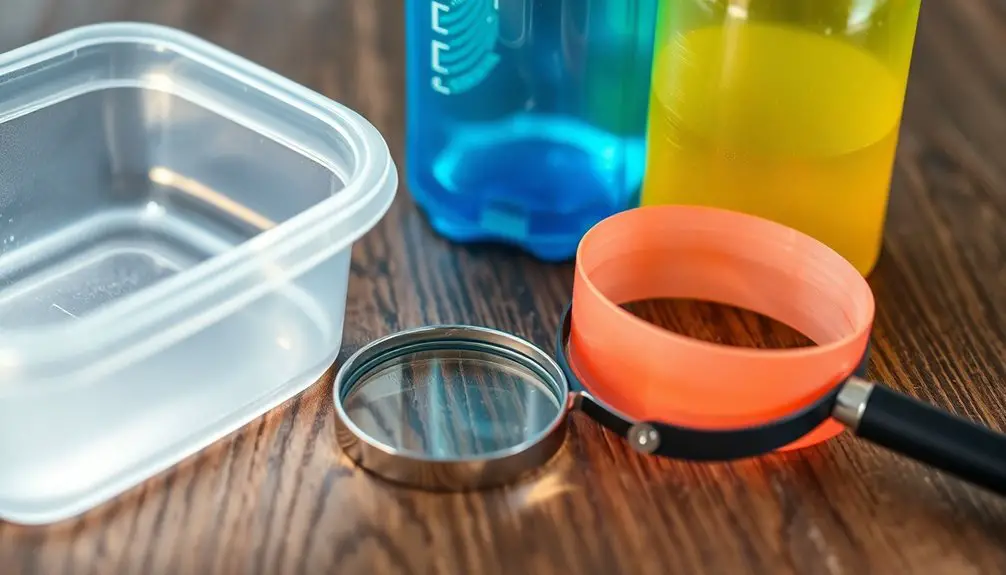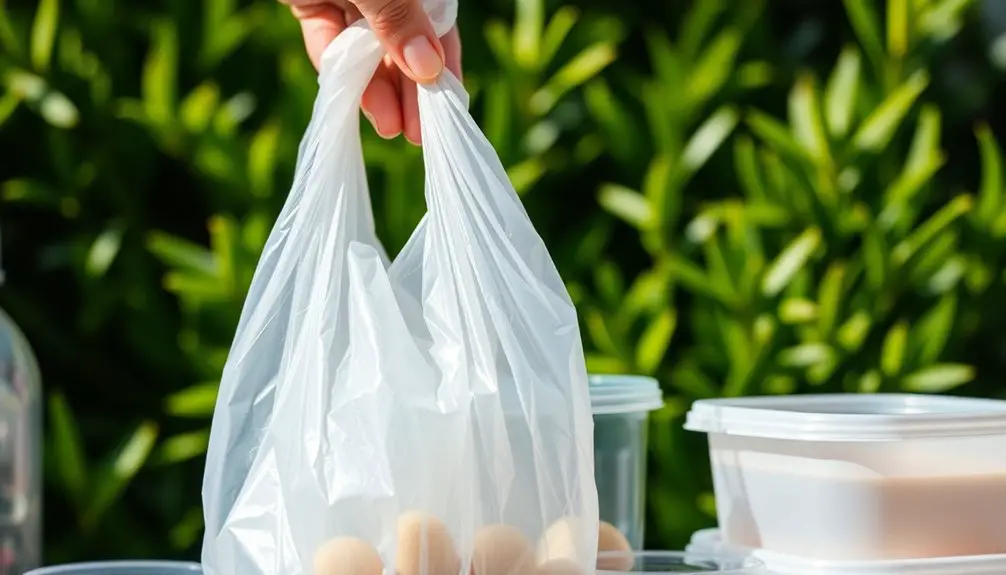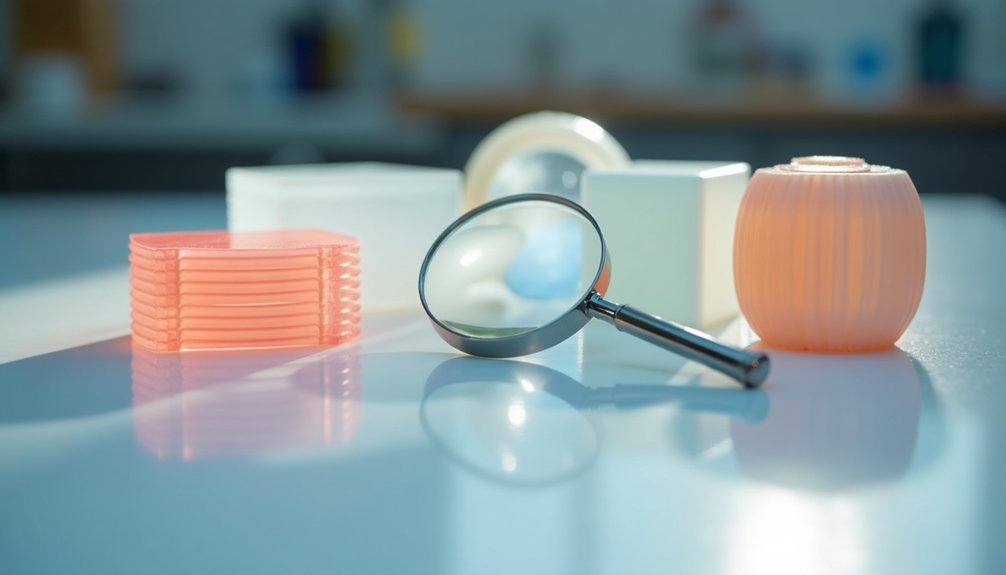To identify polypropylene plastic, look for the recycling symbol #5, which confirms its identity. Check its flexibility; it should bend easily without breaking. You can also perform a float test in water—polypropylene floats due to its lower density. If you burn it, expect a smell reminiscent of dirty engine oil and candle wax. Visually, it's usually translucent or semi-translucent and can be found in various colors. Keep these tests in mind, and you'll be able to spot polypropylene in no time, and there's more to explore about its properties and uses just ahead.
Key Takeaways
- Look for the recycling symbol #5, which confirms the material is polypropylene.
- Conduct a flexibility test; polypropylene bends easily without breaking.
- Perform the float test; polypropylene will float in room temperature water due to its lower density.
- Use the burning test; polypropylene emits a distinctive smell resembling dirty engine oil when burned.
- Inspect for transparency; polypropylene is typically translucent or semi-translucent and available in various colors.
Basics of Polypropylene Plastic
Polypropylene plastic, often referred to as PP, is a remarkable thermoplastic polymer that's found in countless everyday products. Its versatility makes it a go-to choice in various industries, particularly in packaging and automotive sectors. Created through the polymerization of propylene monomers, polypropylene is known for being lightweight yet strong and tough, providing durability without adding excess weight.
One of the standout features of polypropylene is its impressive chemical resistance. It can withstand exposure to a variety of chemicals, acids, and bases, making it ideal for applications that require materials to maintain integrity under harsh conditions.
Additionally, with a melting point of approximately 171 °C, polypropylene can hold its form even when subjected to moderate heat, which is crucial for many manufacturing processes.
Moreover, polypropylene has low water absorption rates, ensuring that it remains stable and effective in wet environments. It's also an excellent electrical insulator, adding to its appeal in the production of electrical components and household items.
Polypropylene is also commonly identified as #5 plastic, often used in food storage containers, yogurt cups, and straws, which is generally considered safe for food contact with low risk of leaching.
Characteristics of Polypropylene
When considering the characteristics of polypropylene, you'll find that it strikes a balance between lightweight design and remarkable strength. This plastic boasts a melting point of around 171 °C, making it ideal for applications requiring durability and heat resistance. Its high chemical resistance allows polypropylene to maintain integrity even in harsh environments, proving it's reliable for various uses. As a common type of plastic, polypropylene is categorized as Code 5 PP in the standard plastic identification system.
Another standout feature is its flexibility. Polypropylene can be easily molded into different shapes without easily breaking, which is crucial for products like packaging and automotive parts. The appearance of polypropylene is typically translucent or semi-translucent, and it comes in a variety of colors such as white, black, blue, green, and beige.
Here's a quick overview of polypropylene's key characteristics:
| Characteristic | Description |
|---|---|
| Weight | Lightweight and easy to handle |
| Strength | Remarkable strength for durability |
| Chemical Resistance | Resistant to acids, bases, and chemicals |
| Flexibility | Can be easily molded into various shapes |
| Electrical Insulation | Excellent insulator for electronics |
With these features, polypropylene is a versatile choice for many applications.
Identification Methods

There are several effective methods to identify polypropylene plastic. First, check for the recycling symbol #5, which confirms it's polypropylene according to international standards.
Next, perform a flexibility test. Polypropylene bends easily without breaking, unlike more rigid plastics like HDPE. This simple test can help you quickly distinguish between materials.
You can also use the float method to further confirm your findings. Place the plastic in purified water; polypropylene has a lower density and will float, while other plastics like LDPE will remain submerged.
Additionally, a burning test can provide valuable information. When you burn polypropylene, it emits a distinctive smell reminiscent of dirty engine oil and candle wax.
You'll also notice it produces water vapor and CO2 when combusted, which can help differentiate it from other materials.
While these methods are practical for everyday identification, keep in mind that professional labs use advanced techniques like FTIR spectroscopy for precise analysis of the material's chemical structure.
However, for most purposes, these simple tests will effectively help you identify polypropylene plastic. When dealing with plastics, it's essential to be aware of the potential risks associated with BPA exposure and to choose safer alternatives, especially when it comes to food storage and preparation.
Testing Procedures
After identifying polypropylene using various methods, you can follow specific testing procedures to confirm its identity.
Start with a visual inspection of your plastic sample. Check for transparency, translucency, or opacity, as these characteristics can offer initial clues about the type of plastic.
Next, conduct a float test by placing the plastic in room temperature water. Polypropylene will float due to its lower density compared to other plastics, providing a straightforward identification.
Then, use a sharp knife for a cutting test. Assess how easily the plastic cuts and the smoothness of the edges, as polypropylene typically produces clean cuts without flaking.
Finally, execute a burning test in a well-ventilated area. When burned, polypropylene emits a distinctive odor similar to dirty engine oil and candle wax, which helps differentiate it from other types of plastics.
Make sure you document all your observations during these tests. Keeping track of these details ensures accurate plastic identification and allows for easy comparison with known characteristics of polypropylene.
Environmental Considerations

Considering the environmental impact of polypropylene is crucial for responsible plastic use. While polypropylene (PP) is recyclable and marked with the recycling code #5, its improper disposal can lead to significant pollution.
Unlike some materials, polypropylene isn't biodegradable, which means it'll persist in the environment if not recycled properly. This highlights the importance of effective recycling and waste management practices to minimize plastic waste.
The production of polypropylene requires considerable energy, contributing to greenhouse gas emissions, which raises concerns about sustainability. However, recycling polypropylene helps reduce its overall environmental impact, making it essential to promote responsible disposal and reuse.
As a consumer, you can play a key role by ensuring that you recycle PP products when possible.
Moreover, researchers are actively exploring biodegradable alternatives to polypropylene, aiming to address the environmental issues linked with traditional plastics.
Staying informed about these alternatives and supporting eco-friendly initiatives can further enhance sustainability efforts. By being mindful of your choices and advocating for proper recycling, you contribute to a healthier planet and help combat the negative consequences of plastic waste.
Approximately 91% of plastic waste generated is not recycled, with only 9% of plastics produced since the 1950s being recycled, emphasizing the need for improved recycling practices.
Frequently Asked Questions
How to Tell if a Plastic Is Polypropylene?
To tell if a plastic's polypropylene, look for the recycling symbol with a 5. Test its flexibility; if it bends easily, and it floats in water, you've likely got polypropylene.
What Is the Symbol for Polypropylene Plastic?
The symbol for polypropylene plastic is a number 5 inside a triangle made of three arrows. You'll often find it on the bottom of containers, making it easier for you to identify and recycle.
How to Tell if Something Is Made of Polyethylene?
To tell if something's made of polyethylene, check for recycling symbols #2 or #4, feel its texture—LDPE is soft and flexible, while HDPE feels tougher. You can also perform a float test for confirmation.
How to Tell the Difference Between HDPE and PP?
To tell the difference between HDPE and PP, check their density: HDPE sinks in water, while PP floats. Also, look at their flexibility—PP bends easily, whereas HDPE stays rigid. Recycling symbols can help too!

